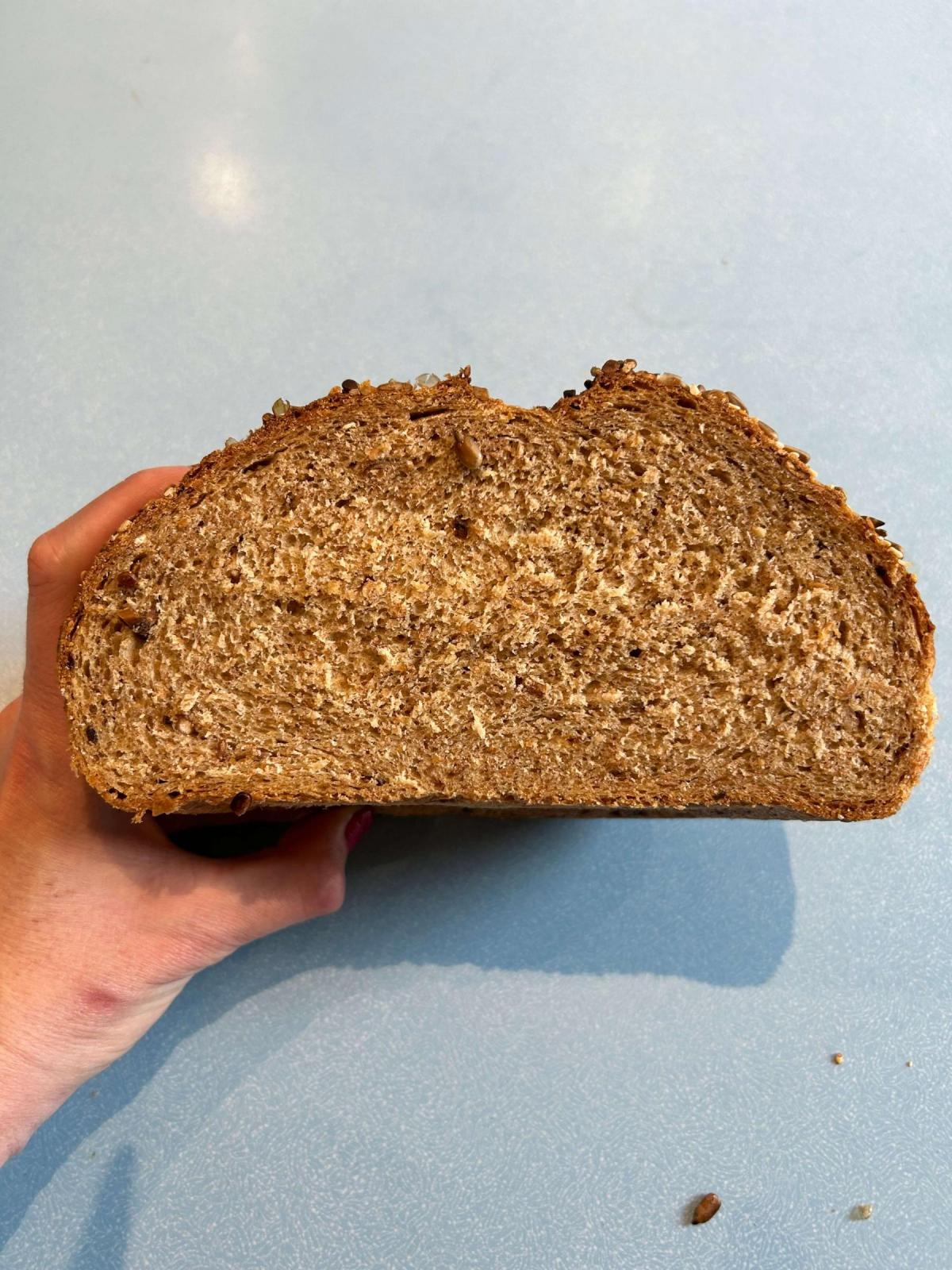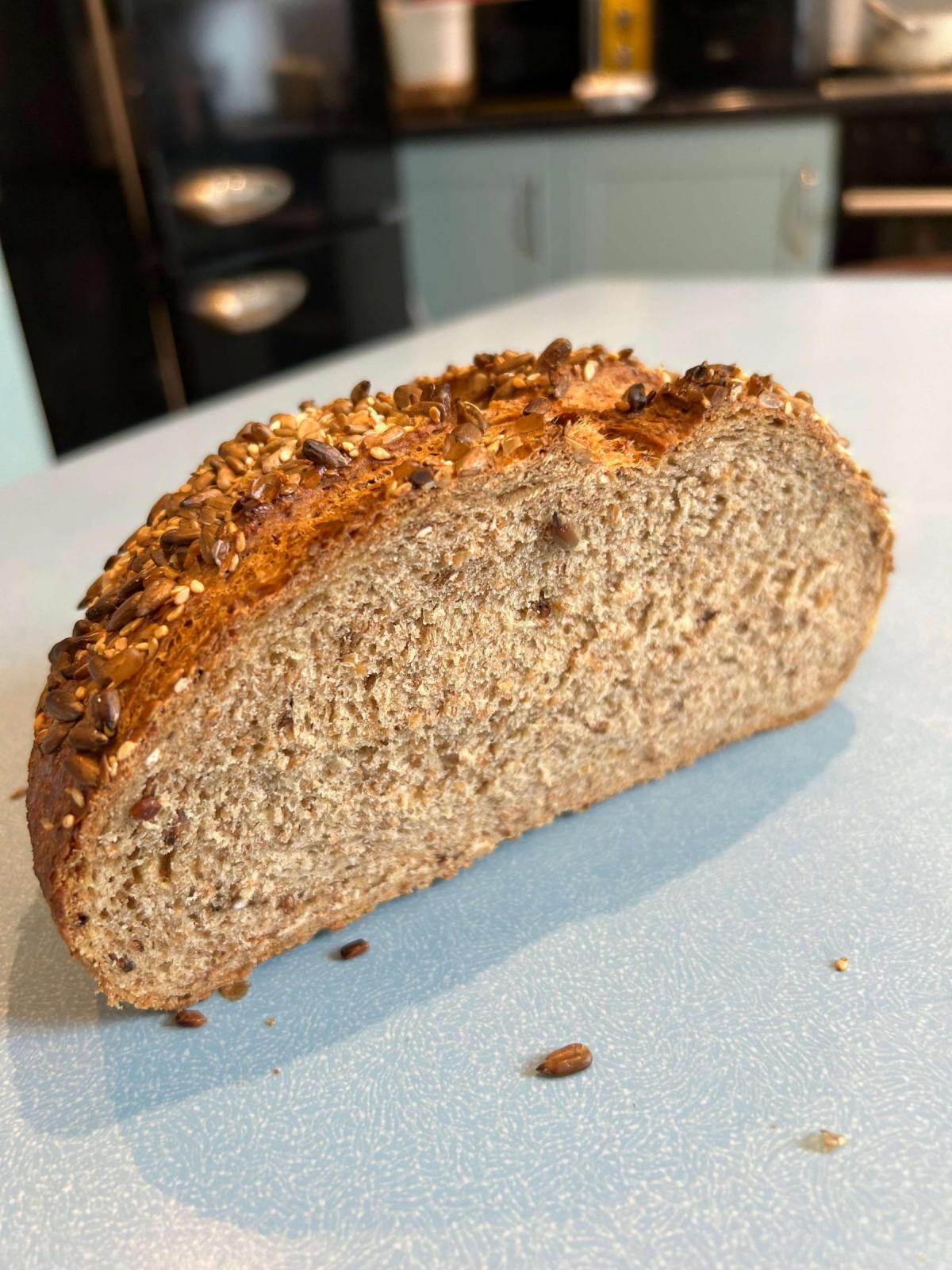October 28, 2024 - 2:37am

Overproofed? Underproofed?
Hey lovely bakers, I'm new here and this isn't a fancy loaf. It's made of wholemeal bread flour, granary and a dash of strong white. It rose a bit but it's no where near as fluffy and airy as I'd like. It looks somehow fluffier in these pics than the actual reality. The crumb is really quite dense. Bulk was for about 50 mins, followed by shaping and a further 40-45 mins. Your thoughts are really appreciated.





welcome...it really helps to give more information to get good feedback...including your whole formula and process.
At first glance, I'm not sure proofing is your main issue...
Ahhhh. I’m a novice. I used 200g granary flour, 100g strong white, 200g wholemeal bread flour, about 300ml water, 7g yeast, 40ml olive oil.
kneaded for 10mins, bulk for 50min, shape and second rise for 40-45min
baked 220C for 25 min, then 200 for 10 min. Had a pan of water in over to create steam.
just that bit helps...a bit...
not sure what the specs are on the granary flour (including falling number(enzyme activity), ash, protein), so that is a bit of a wild card...but with the strong and whole grain flours, which take up a lot more water, I would definitely increase the amount of water. You are at 60% hydration, which again for those flours, is pretty low...I'd go at least up to 70% and 75% is a pretty conservative target.
next...especially when using substantial amounts of whole grain flours (again, not sure just what the granary flour you are using is), extensive kneading/mixing is really important...make sure you can pull a nice uniform gluten window to know you have gone far enough. You might try extending your fermentation times, as those look pretty short for bulk and proof, but always go by what your dough is doing (there are plenty of resources for judging that online, and I like those from Maurizio at The Perfect Loaf a lot).
finally...I'd learn baker's math and start using it (using weights in grams is a good start, and this is a good next step).
good luck!
Seeing your formula that you posted above, your hydration for this bread (in bakers percentage) is only around 60% plus 8% olive oil. Whole wheat flour is pretty thirsty, it can take a while for the flour (more specifically the bran) to soak all the water, a dough that looks wet at the start can turn real dry and stiff an hour later. I did not take this into account my first time making whole wheat bread (100% whole wheat because I thought why not). I ended up with a pretty wet hydratation on paper (80%-ish hydration with 15% seeds) in the formula, ended up with a really dry and crumbly loaf of bread. You haven't mentioned how dry the dough or finished bread is, so I'm kinda guessing at this point, maybe you can inform how dry it was. I am also not familiar with your flour's specific performance.
Also, I second bikeprof on the fermentation, the fermentation times are a relatively brief. You used a good amount of yeast though, so fermentation might have went pretty fast. Always a good practice to watch the dough (how much it rises) above timing.
Give it 1 more rise before baking.
After the first hour - double in size - double again - rise and shape to double - bake.
That'll get ya going. Enjoy!
Coarse flour and barn flour can really create a denser crumb because of their high fiber content. Try mixing them with white flour to improve the texture.
The dough is too dry. In any case you can not expect to get a store-grade fluffy wholemeal bread without injection of gluten and other baking additives.
loaf. Take a look at this simple 100% whole wheat bread—maybe a few of the techniques will help improve yours:
https://www.thefreshloaf.com/node/71297/20221020-simple-100-wholewheat-bread-clas
Yippee
My general hydration for white flours is 66.7% and for whole grain (freshly milled) 80%. With the rye sourdough clas, you can do a straight mix (20-30 min in a good mechanical mixer) followed by a 2 hr rise and a 1 hr final rise. The clas sourdough will beautifully condition the whole grain flour and the loaf will not be dense. I love this clas bread formula!
Also you might look at the general method of pizza makers like these 2 on YT. 50% WW and 100% WW I learned a lot from these YTs . The recipes use dry instant yeast. For a loaf or boule, I decrease the liquid to the above percentages for hydration (80% -ww; 67% white flour).
Hope to see more of your work!
I spot a few issues that are easily correctible. I believe the dough needs more water, time to absorb it and more kneading to develop a good windowpane.
Whole grain is a little different from using all AP or white bread flour. Yes-WW (whole grain/granary/etc) needs more water but almost more importantly, they need some time to absorb it. All the branny bits-no matter how finely ground, need at least 30-60 minutes of time just sitting. It can be at room temp after mixing or in the refrigerator overnight. The simplest method is to mix and let rest for that time-called an "autolyse". If there is enough water, the dough will be sticky at first and as it rests it will become tacky. The difference between sticky and tacky is that sticky dough sticks to the finger when firmly touched whereas with tacky dough, the finger pulls away with very little to no dough sticking- like a post it note. Now it is time to knead.
Even the roughest WW dough can develop a good windowpane. Some people call it developing the gluten, I say the sticky gel needs to be develop as the gluten aligns. Use the search box to look for pics of a good window pane.
There may be some bulk ferment time issues going on,also Your times seem a little short, though there is a goodly amount of yeast. Try these suggestions and keep a close eye on the bulk fermentation. If you are fermenting at about 80-90F, proceed when a finger poke fills in very slowly or barely at all. It doesn't have to double. 3/4 is good. And it doesn't have to match a recipe's time frame. Those are just guidelines. Keep an eye on the dough-not the clock.
So try these ideas and get back to us. I love a good wholegrain bread story.